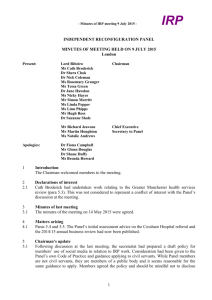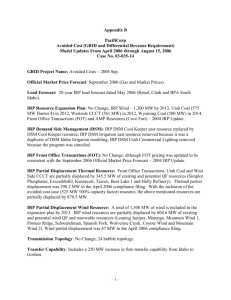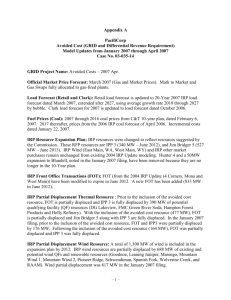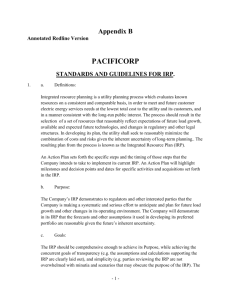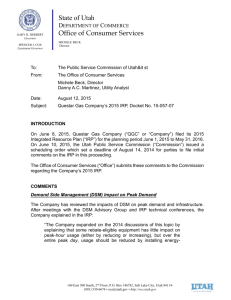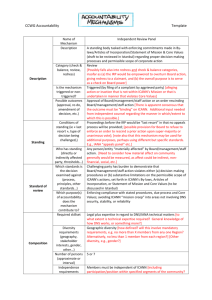IRPs
advertisement
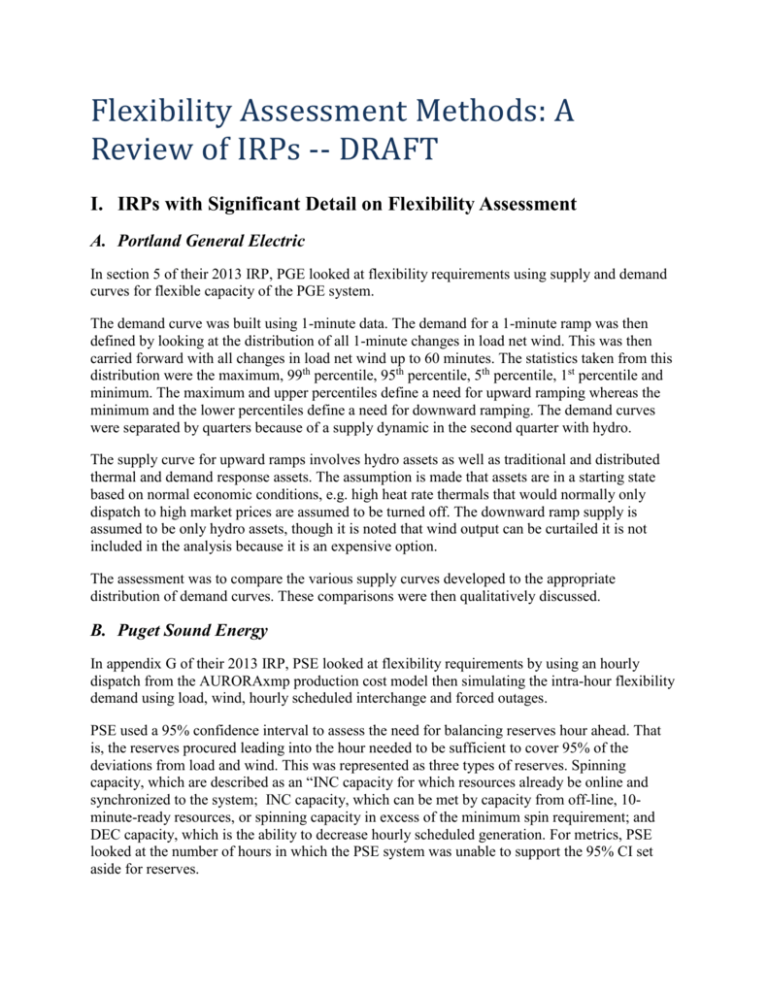
Flexibility Assessment Methods: A Review of IRPs -- DRAFT I. IRPs with Significant Detail on Flexibility Assessment A. Portland General Electric In section 5 of their 2013 IRP, PGE looked at flexibility requirements using supply and demand curves for flexible capacity of the PGE system. The demand curve was built using 1-minute data. The demand for a 1-minute ramp was then defined by looking at the distribution of all 1-minute changes in load net wind. This was then carried forward with all changes in load net wind up to 60 minutes. The statistics taken from this distribution were the maximum, 99th percentile, 95th percentile, 5th percentile, 1st percentile and minimum. The maximum and upper percentiles define a need for upward ramping whereas the minimum and the lower percentiles define a need for downward ramping. The demand curves were separated by quarters because of a supply dynamic in the second quarter with hydro. The supply curve for upward ramps involves hydro assets as well as traditional and distributed thermal and demand response assets. The assumption is made that assets are in a starting state based on normal economic conditions, e.g. high heat rate thermals that would normally only dispatch to high market prices are assumed to be turned off. The downward ramp supply is assumed to be only hydro assets, though it is noted that wind output can be curtailed it is not included in the analysis because it is an expensive option. The assessment was to compare the various supply curves developed to the appropriate distribution of demand curves. These comparisons were then qualitatively discussed. B. Puget Sound Energy In appendix G of their 2013 IRP, PSE looked at flexibility requirements by using an hourly dispatch from the AURORAxmp production cost model then simulating the intra-hour flexibility demand using load, wind, hourly scheduled interchange and forced outages. PSE used a 95% confidence interval to assess the need for balancing reserves hour ahead. That is, the reserves procured leading into the hour needed to be sufficient to cover 95% of the deviations from load and wind. This was represented as three types of reserves. Spinning capacity, which are described as an “INC capacity for which resources already be online and synchronized to the system; INC capacity, which can be met by capacity from off-line, 10minute-ready resources, or spinning capacity in excess of the minimum spin requirement; and DEC capacity, which is the ability to decrease hourly scheduled generation. For metrics, PSE looked at the number of hours in which the PSE system was unable to support the 95% CI set aside for reserves. For intra-hour flexibility PSE modeled 10-minute level wind and load deviations along with the need to balance hourly shifts. They then calculated the times when the committed resources were unable to follow the load, i.e. there was either unserved energy or excess energy. For metrics they used the average megawatts of unserved and excess energy, a “proxy CPS2 score” which did not include frequency bias, as well as the percentage of increments with shortfall for spin requirements and average megawatts for that shortfall. II. IRPs without Significant Detail on Flexibility Assessment C. Avista Avista states in their IRP that they plan for operating reserves, regulation, load following, wind integration and a planning margin. The IRP included a forecast of reserve needs. Methods for forecasting were unclear. D. Bonneville Power Administration (Resource Program) BPA in their 2013 Resource Program anticipate a shortage of balancing reserves. The Resource Program references the White Book Federal System Needs Assessment for this result. For the 2012 Needs Assessment, BPA modeled a FCRPS reserve limit of 900 MW incremental and 1,100 MW decremental and used the delta between those and the forecast requirement to calculate the need. E. Clark County PUD Clark County PUD in their 2012 IRP does not have a method for assessing the system capability to meet flexibility requirements. F. Eugene Water and Electric Board EWEB in their 2011 IERP speaks specifically to the ability of demand response to provide flexibility but does not have a method for assessing the system capability to meet flexibility requirements. G. Idaho Power Idaho Power states in their 2013 IRP that changes in intermittent generation will be the primary driver of future reserve requirements. They point to their Wind Integration Study Report for details. They do not propose in their IRP to add significant intermittent generation and thus they conclude that the current supply of flexible capacity is sufficient, presumably because the system is capable of meeting current ramping requirements. H. Northwestern Energy Northwestern in their 2013 IRP primarily depended on the PowerSimm software which is an hourly dispatch production cost model. Reserves were likely forecast and treated as an input into the model. I. PacifiCorp In appendix F of their 2013 IRP PacifiCorp forecasted the need for spinning and non-spinning reserves and forecasted the supply of flexible resources. The supply forecast included all resources capable of providing spinning reserves. Primarily these are hydro and thermal resources. They specifically state the reserve capability of natural gas-fired resources can be close to the difference between the nameplate capacity and the minimum generation. There was no forecast of downward reserves or evaluation of the supply in the IRP. However, downward reserves were covered in the wind integration section of the IRP. J. Seattle City Light Seattle in their 2012 IRP used the AURORAxmp software which is an hourly dispatch production cost model. Reserves were likely forecast and treated as an input into the model. K. Snohomish County PUD Snohomish County PUD in their 2013 IRP assigned a letter grade to potential resources for dispatchability and flexibility. They did not pursue a quantitative method to evaluate supply and demand for flexibility. They state current within hour balancing is performed by BPA, but anticipate that future variable generation resources will need to be paired with flexible resources. L. Tacoma Power Tacoma Power in their 2013 IRP use a consultant Wood Mackenzie that runs the AURORAxmp production cost model. Reserves were likely forecast and treated as an input into the model.
